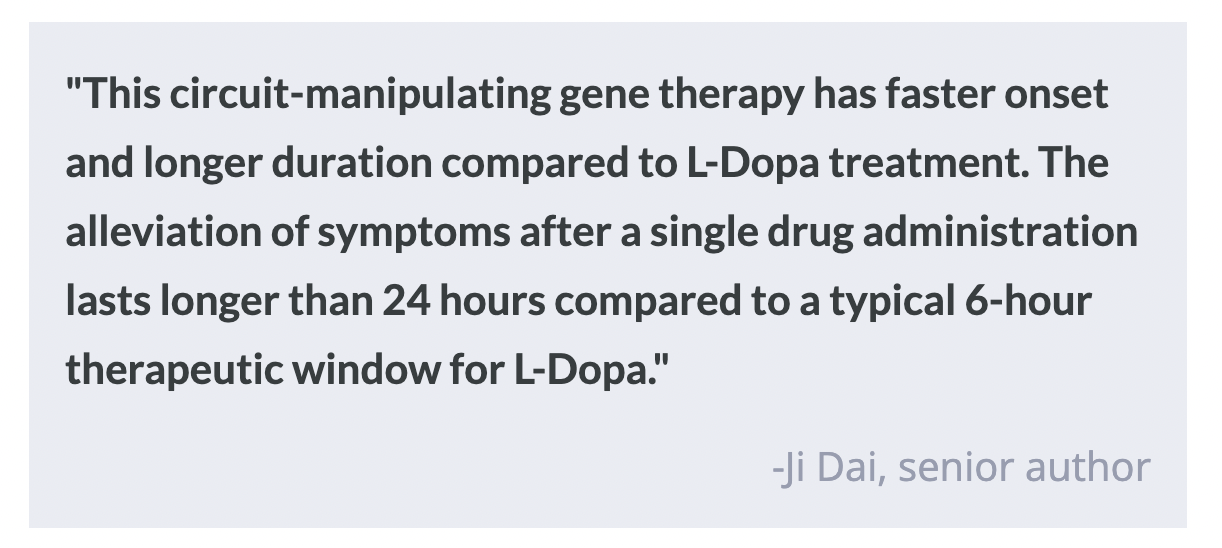Targeted Gene Therapy for Symptom Relief in Parkinson’s Disease
Post by Laura Maile
The takeaway
In Parkinson’s disease (PD), dopaminergic neurons of the striatum are lost over time, leading to symptoms like tremor and slow movement. Gene therapy can target the specific neurons lost in PD and enhance their activity, leading to an improvement of symptoms in both mouse and monkey models of PD.
What's the science?
PD is a debilitating neurodegenerative disorder that results in the loss of dopaminergic neurons in the basal ganglia that are involved in motor control. Existing systemic treatments, such as Levodopa, that work to boost dopamine have limited success in the later stages of PD due to their lack of specificity and negative side effects like Levodopa-induced dyskinesia. Scientists have been working to develop cell-specific treatments that target only the circuits affected in PD. One method utilized in rodents uses the injection of viral recombinases to genetically modify specific cell types, but this method is not clinically translatable to humans. This week in Cell, Chen and colleagues used a translatable chemogenetic method to genetically modify the specific cells affected by PD and then activate them with a systemic drug to alleviate symptoms associated with PD.
How did they do it?
The authors used a retrograde adeno-associated virus (AAV) injected into the substantia nigra pars reticulata (SNr) to target the axon terminals of D1 dopaminergic neurons affected in PD. This AAV contained D1 cell-specific DNA promoters (i.e., region of DNA where transcription starts) and enhancers (i.e., region of DNA that promotes transcription) to drive expression of a chemogenetic receptor that could be targeted with a designer drug to activate the intended cells. Using different mutated versions of the AAV, they first identified a specific AAV type that improved retrograde efficiency and infectability of D1 neurons to achieve maximum expression in this cell population. They then identified genes that are enriched in the striatum, and located enhancer and promoter regions of DNA that are associated with these striatum-specific genes. The homologous sequences in human DNA were then cloned to make the AAVs, and tested in mice to determine which promoter region was best at driving expression in D1 neurons in the striatum.
Next, they tested the effectiveness of retrograde expression in primates by injecting their chosen retrograde AAV into the SNr and visualizing its expression colocalized with labeled D1 dopamine neurons in the striatum. To modify the activity of D1 striatal neurons, they engineered their AAV to include a chemogenetic receptor that can effectively activate a cell upon application of a designer drug. They tested the utility of this chemogenetic method using slice electrophysiology recordings and by administering the designer drug in live animals previously injected with their AAV. Next, they used a mouse model of PD that reduces the population of dopaminergic striatal neurons and results in bradykinesia, or slow movement, both cardinal features of human PD. They bilaterally injected their engineered retrograde AAV in PD animals to target the axon terminals of these dopaminergic neurons and administered the designer drug to activate the chemogenetic receptor. Finally, they tested motor behaviors in PD animals before and after treatment with a single dose of designer drug to determine whether their chemogenetic viral strategy could be effective at treating the core symptoms of PD. To determine the long-term efficacy of this treatment, they consistently treated monkeys with the designer drug for eight months and compared their motor behaviors with those that received long-term treatment with Levodopa.
What did they find?
After designing a series of retrograde AAVs containing different human promoter/enhancer regions specific to genes associated with the striatum, they selected AAV8R12-G88P7-EYFP. After injecting this virus into the SNr of mice, they determined that the vast majority of labeled neurons were D1+ and located in the striatum. This meant that their selected virus effectively transfected the targeted cell population with minimal expression outside of the intended cells. After repeating the injections in macaque monkeys, they found similar success, indicating the feasibility of their viral approach. Both mice and macaques injected with the AAV genetically designed to include a chemogenetic receptor used to activate cells showed increased excitability of the targeted D1 striatal neurons. This indicated the effectiveness of their viral strategy to activate the targeted neuron population.
In a mouse model of PD, using their viral strategy to activate D1 striatal neurons resulted in a partial rescue of Parkinson-like motor deficits. The same strategy used in macaques with a model of PD resulted in a reduction or total reversal of all PD symptoms including tremor, bradykinesia, and rigidity, without affecting motor behaviors in naïve monkeys. This relief of PD symptoms lasted for eight months with consistent use of the same dose of designer drug required to activate the chemogenetic receptor. When compared to ongoing treatment with Levodopa, a current treatment for human PD, the authors’ designer viral strategy resulted in a longer window of symptom relief after drug administration and did not result in dyskinesia, a common negative side effect of long-term Levodopa treatment. This demonstrates the long-term safety and efficacy of using this strategy to treat the core symptoms of PD in primates.
What's the impact?
This study found that chemogenetic manipulation of striatal dopaminergic neurons with designer drugs can enhance their activity and alleviate PD symptoms, and has improved long-term efficacy over current PD treatments. This means there may be safe, effective ways to increase the activity of the neurons that are compromised in PD, resulting in long-term improvements to symptoms like tremor and slow movement. This is promising for the future of gene therapy treatments in humans that target specific brain circuitry affected in PD and other neurodegenerative diseases and may lead to a treatment alternative for those in later stages of PD.


